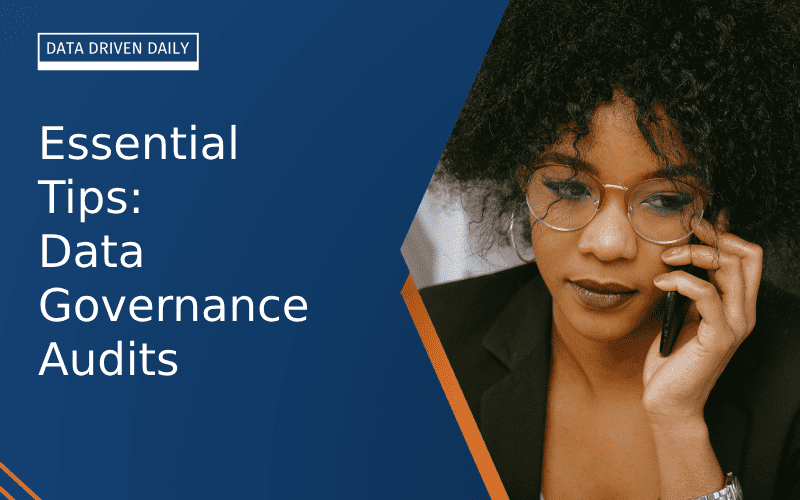We all know data is a pivotal asset for organizations, driving decision-making and strategy.
However, with great data comes great responsibility.
A data governance audit is a critical exercise that ensures your data management practices align with both internal policies and external regulatory requirements. Let’s dive into the essential steps to conduct a data governance audit effectively, offering insights and depth around this crucial topic.

Understanding Data Governance Audit
Before we delve into the steps, let’s clarify what a data governance audit involves. It’s a thorough review of how data is acquired, stored, managed, and secured within an organization. The goal? To ensure compliance, improve data quality, and minimize risks associated with data mismanagement.
Step 1: Establish Your Audit Objectives
Identify the Scope: What specific aspects of data governance will the audit cover? Is it focused on compliance, data quality, or overall management? Defining this early on sets a clear direction for the audit process.
Set Clear Objectives: What do you aim to achieve with the audit? Whether it’s ensuring regulatory compliance, identifying gaps in data quality, or enhancing data security, having clear objectives is crucial.
Step 2: Assemble Your Audit Team
A multidisciplinary team is key. Include members from IT, legal, compliance, and the business units that handle data. Each member brings a unique perspective, ensuring a comprehensive approach to the audit.
Step 3: Develop an Audit Framework
Establish Evaluation Criteria: What standards or regulations are you measuring against? This could include GDPR, HIPAA, or specific industry standards relevant to your organization.
Define Key Data Elements: Identify which data elements are critical for your audit. Focus on the data that impacts decision-making, regulatory compliance, and operational efficiency.
Step 4: Data Inventory and Mapping
Create a Data Inventory: List all data sources, types, and storage locations. Understanding where your data resides is the first step in securing it.
Map Data Flows: Trace how data moves through your organization. This reveals the lifecycle of your data, from creation to deletion, and helps identify potential risk points.
Step 5: Assess Data Management Practices
Review Data Quality: Is the data accurate, complete, and reliable? Poor data quality can lead to flawed decision-making and operational inefficiencies.
Evaluate Data Accessibility: Who has access to what data? Ensuring appropriate access control is vital for data security and compliance.
Step 6: Identify Risks and Non-compliance Issues
Spot Potential Risks: Look for vulnerabilities in how data is stored, processed, and shared. This includes assessing the risk of data breaches and non-compliance with regulations.
Document Non-compliance Issues: If any practices don’t align with regulatory requirements or internal policies, document these clearly.
Step 7: Develop an Action Plan
Prioritize Issues: Not all findings will carry the same weight. Prioritize them based on their potential impact on the organization.
Create a Roadmap for Remediation: For each identified issue, outline a plan to address it. This might include revising policies, enhancing security measures, or improving data management practices.
Step 8: Implement Changes and Monitor Progress
Execute the Action Plan: Implement the necessary changes to address the identified issues. This may require a phased approach, depending on the complexity and scope of the required actions.
Monitor and Report: Continuously monitor the progress of the implemented changes. Regular reporting keeps stakeholders informed and ensures transparency throughout the process.
Step 9: Foster a Culture of Continuous Improvement
Promote Data Governance Awareness: Educate employees about the importance of data governance and their role in it. A well-informed workforce is your first line of defense against data mismanagement.
Implement Ongoing Audits: A one-time audit isn’t enough. Establish a schedule for regular audits to ensure ongoing compliance and data governance maturity.
Final Thoughts and Tips
Embarking on a data governance audit can seem daunting, yet it’s an invaluable process that fortifies your organization’s data management and compliance posture. To wrap up, here are some final thoughts and tips to ensure your data governance audit is not just thorough but also a catalyst for meaningful change.
Embrace a Proactive Stance: Don’t wait for a data breach or a regulatory fine to prompt an audit. Proactive data governance safeguards your organization and builds trust with stakeholders.
Leverage Technology: Utilize data governance tools and software to streamline the audit process. These technologies can automate data inventory, mapping, and risk assessment, allowing you to focus on strategic decision-making.
Communication is Key: Ensure transparent and ongoing communication with all stakeholders throughout the audit process. This fosters a collaborative atmosphere and ensures alignment with organizational goals.
Customize Your Approach: While the steps outlined provide a general framework, tailor the audit to fit your organization’s unique context. Factors like industry, size, data types, and regulatory environment should influence your approach.
Learn from Each Audit: Every audit is a learning opportunity. Document lessons learned and integrate them into future audits and data governance strategies.
Commit to Continuous Improvement: Data governance is not a one-time project but an ongoing commitment. Regular audits, continuous monitoring, and adapting to new challenges and regulations are essential for maintaining data integrity and compliance.
By following these steps and embracing these tips, you’re not just conducting an audit; you’re paving the way for a culture that values and effectively manages one of its most critical assets—data. Remember, in the world of data governance, an audit is not the end but a step toward continual improvement and excellence in data management.
Ben is a full-time data leadership professional and a part-time blogger.
When he’s not writing articles for Data Driven Daily, Ben is a Head of Data Strategy at a large financial institution.
He has over 12 years’ experience in Banking and Financial Services, during which he has led large data engineering and business intelligence teams, managed cloud migration programs, and spearheaded regulatory change initiatives.